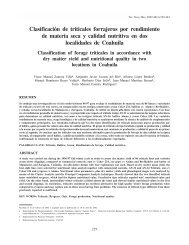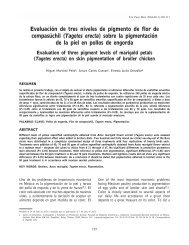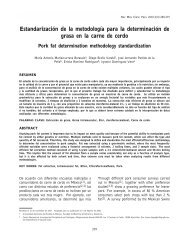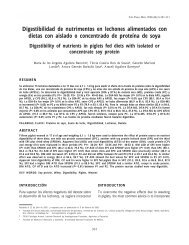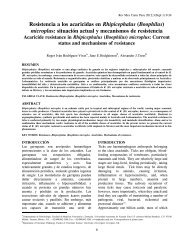Control de Rhipicephalus microplus - Revista Técnica Pecuaria en ...
Control de Rhipicephalus microplus - Revista Técnica Pecuaria en ...
Control de Rhipicephalus microplus - Revista Técnica Pecuaria en ...
You also want an ePaper? Increase the reach of your titles
YUMPU automatically turns print PDFs into web optimized ePapers that Google loves.
Melina Maribel Ojeda-Chi, et al. / Rev Mex Ci<strong>en</strong>c Pecu 2011;2(2):177-192<br />
(<strong>en</strong>zimas producidas por M. anisopliae) relacionadas<br />
con la pre-p<strong>en</strong>etración y crecimi<strong>en</strong>to <strong>en</strong> la cutícula<br />
<strong>de</strong>l hospe<strong>de</strong>ro (42). A<strong>de</strong>más posee la proteína quinasa<br />
A, importante para la difer<strong>en</strong>ciación <strong>de</strong> las<br />
estructuras apresoras, p<strong>en</strong>etración y <strong>de</strong>gradación<br />
<strong>de</strong> la cutícula, adquisición <strong>de</strong> nutri<strong>en</strong>tes, regulación<br />
<strong>de</strong> pH, síntesis <strong>de</strong> lípidos, control <strong>de</strong>l ciclo celular<br />
y <strong>de</strong>l citoesqueleto (43).<br />
Invasión. A las 96 h pos infección las hifas<br />
colonizan el huésped y emerg<strong>en</strong> <strong>de</strong> la cutícula.<br />
Una vez <strong>de</strong>ntro <strong>de</strong>l insecto, el hongo se disemina<br />
vía hemolinfa y produce blastosporas y cuerpos<br />
filam<strong>en</strong>tosos <strong>de</strong> hifas que inva<strong>de</strong>n el sistema inmune<br />
<strong>de</strong>l hospe<strong>de</strong>ro y se multiplican rápidam<strong>en</strong>te <strong>en</strong> los<br />
tejidos. A<strong>de</strong>más produc<strong>en</strong> dos familias <strong>de</strong> toxinas<br />
que son las <strong>de</strong>struxinas y las citocalacinas. De la<br />
primer familia se han aislado 14 toxinas, <strong>de</strong> las<br />
cuales las más comunes son: A, B, C, D, diesmetil<strong>de</strong>struxina<br />
B y proto<strong>de</strong>struxina. En la segunda, se<br />
<strong>en</strong>cu<strong>en</strong>tra la citocalacina A y D. La función <strong>de</strong><br />
estas toxinas es inhibir el sistema inmunológico<br />
<strong>de</strong>l artrópodo, causando su muerte, a<strong>de</strong>más ti<strong>en</strong>e<br />
efecto sobre la fecundidad y viabilidad <strong>de</strong> los huevos<br />
incubados (38,44,45).<br />
Colonización. La colonización <strong>de</strong>l hongo <strong>en</strong> los<br />
órganos <strong>de</strong>l artrópodo se produce <strong>en</strong> la sigui<strong>en</strong>te<br />
secu<strong>en</strong>cia: cuerpos grasosos, sistema digestivo,<br />
tubos <strong>de</strong> malpigio, hipo<strong>de</strong>rmis, sistema nervioso,<br />
músculos y tráquea. Bitt<strong>en</strong>court et al (41) m<strong>en</strong>cionan<br />
que la p<strong>en</strong>etración <strong>de</strong>l hongo <strong>en</strong> los órganos ocurre<br />
al quinto día pos infección invadi<strong>en</strong>do también los<br />
órganos reproductivo y digestivo.<br />
Muerte. Esta se <strong>de</strong>be a las micotoxinas, cambios<br />
patológicos <strong>en</strong> el hemocele, acción histolítica y<br />
bloqueo mecánico <strong>de</strong>l aparato digestivo, secundario<br />
al crecimi<strong>en</strong>to <strong>de</strong> las hifas (35).<br />
Emerg<strong>en</strong>cia. Se produce <strong>de</strong>spués <strong>de</strong> la muerte <strong>de</strong>l<br />
insecto y cuando las condiciones <strong>de</strong> humedad<br />
relativa son a<strong>de</strong>cuadas. La emerg<strong>en</strong>cia <strong>de</strong>l micelio<br />
se realiza a través <strong>de</strong>l tegum<strong>en</strong>to, crece <strong>en</strong> la<br />
superficie y esporula <strong>de</strong>spués <strong>de</strong> 48 a 60 h <strong>de</strong> la<br />
muerte <strong>de</strong>l hospe<strong>de</strong>ro (40,46).<br />
Se ha <strong>de</strong>mostrado que M. anisopliae no causa<br />
efectos colaterales <strong>en</strong> los animales <strong>de</strong> sangre cali<strong>en</strong>te<br />
184<br />
arthropod’s immune system, which results in its<br />
<strong>de</strong>ath. In addition, toxins have effects on the<br />
fecundity and livability of incubating eggs (38,44,45).<br />
Colonization. Arthropod organ colonization by the<br />
fungus fulfills the following sequ<strong>en</strong>ce: fatty bodies,<br />
digestive tract, Malpighian tubes, hypo<strong>de</strong>rmis,<br />
nervous system, muscles, and trachea. Bitt<strong>en</strong>court<br />
et al (41) reported that organ p<strong>en</strong>etration by the<br />
fungus occurs on day 5 p.i., and that the<br />
reproductive and digestive organs are also inva<strong>de</strong>d.<br />
Death. Death is caused by mycotoxins, pathological<br />
changes in the hemocele, hystolytic action, and<br />
physical blocking of the digestive system, secondary<br />
to hyphal growth (35).<br />
Emerg<strong>en</strong>ce. After insect <strong>de</strong>ath and in the face of<br />
a<strong>de</strong>quate relative humidity, the fungus emerges.<br />
Mycelium emerg<strong>en</strong>ce occurs through the tegum<strong>en</strong>t.<br />
The fungus th<strong>en</strong> grows on the surface and sporulates<br />
by 48 to 60 h after host <strong>de</strong>ath (40,46).<br />
M. anisopliae has shown not to cause si<strong>de</strong> effects on<br />
either warm blood animals or the <strong>en</strong>vironm<strong>en</strong>t (47). Studies<br />
have shown that it is only toxic for insect cells, not<br />
affecting human cells, bacteria or protozoa (48). On the<br />
other hand, Leyva et al (49) reported that M. anisopliae<br />
Ma2 strain has no pathog<strong>en</strong>ic, toxic, or allergic effects,<br />
and it does not cause appetite loss, diarrhea or <strong>de</strong>ath<br />
in Wistar rats. It is also worthy to m<strong>en</strong>tion that un<strong>de</strong>r<br />
field conditions M. anisopliae affects specifically its<br />
target host thus reducing the possibility of affecting<br />
other beings pres<strong>en</strong>t in the field (50). Rath et al (35,51)<br />
reported that the application on the vegetation of M.<br />
anisopliae for the control of the un<strong>de</strong>rground beetle<br />
Adoryphorus couloni (Burmeister), does not have<br />
negative effects on other invertebrates. In addition,<br />
contrary to conv<strong>en</strong>tional acarici<strong>de</strong>s, myco-acarici<strong>de</strong>s<br />
do not affect the <strong>en</strong>vironm<strong>en</strong>t (28).<br />
c) In vitro/in vivo effects<br />
Table 1 lists in vitro results reported by differ<strong>en</strong>t<br />
authors after the treatm<strong>en</strong>t of adult/instar stages of<br />
R. <strong>microplus</strong> with differ<strong>en</strong>t fungal strains and<br />
conc<strong>en</strong>trations. Virul<strong>en</strong>ce/pathog<strong>en</strong>icity variations<br />
are influ<strong>en</strong>ced by factors such as variations in the<br />
secretion of proteases and chitinolytic <strong>en</strong>zymes



